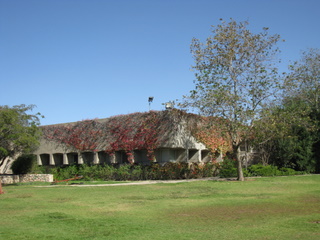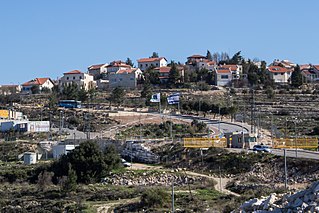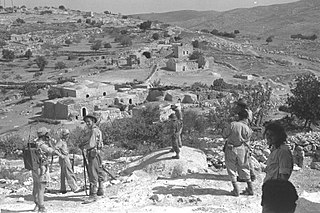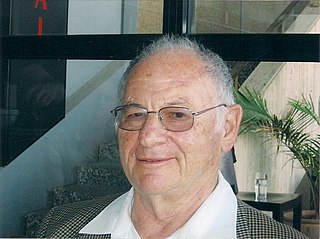Related Research Articles

Shimon Avidan, born Siegbert Koch, was a Palmach soldier and IDF military leader. He was the commander of the Givati Brigade during the 1948 Arab-Israeli war.

The Kfar Etzion massacre refers to a massacre of Jews that took place after a two-day battle in which Jewish Kibbutz residents and Haganah militia defended Kfar Etzion from a combined force of the Arab Legion and local Arab men on May 13, 1948, the day before the Israeli Declaration of Independence. Of the 127 Haganah fighters and Jewish kibbutzniks who died during the defence of the settlement, Martin Gilbert states that fifteen were killed on surrendering.

Gush Etzion is a cluster of Israeli settlements located in the Judaean Mountains, directly south of Jerusalem and Bethlehem in the West Bank. The core group includes four Jewish agricultural villages that were founded in 1943–1947, and destroyed by the Arab Legion before the outbreak of the 1948 Arab–Israeli War, in the Kfar Etzion massacre. The area was left outside of Israel with the 1949 armistice lines. These settlements were rebuilt after the 1967 Six-Day War, along with new communities that have expanded the area of the Etzion Bloc. As of 2011, Gush Etzion consisted of 22 settlements with a population of 70,000.

The Palmach was the elite combined strike forces and sayeret unit of the Haganah, the underground army of the Yishuv during the period of the British Mandate for Palestine. The Palmach was established in May 1941. By the outbreak of the 1948 Arab–Israeli War, it consisted of over 2,000 men and women in three fighting brigades and auxiliary aerial, naval and intelligence units. With the creation of Israel's army, the three Palmach Brigades were disbanded. This and political reasons compelled many of the senior Palmach officers to resign in 1950.

Kfar Etzion is an Israeli settlement in the West Bank, organized as a religious kibbutz located in the Judean Hills between Jerusalem and Hebron in the southern West Bank, established in 1927, depopulated in 1948 and re-established in 1967. It is located 4.7 km east of the Green Line and falls under the jurisdiction of Gush Etzion Regional Council. In 2022, Kfar Etzion had a population of 1,371.

The Convoy of 35, was a convoy of Haganah and Palmach fighters sent during the 1947–48 Civil War in Mandatory Palestine on a mission to reach by foot and resupply the blockaded kibbutzim of Gush Etzion in January 1948, after earlier motorized convoys had been attacked. They were spotted before they could reach their destination and killed in a prolonged battle by Arab irregulars and local villagers.

Neve Daniel is an Israeli settlement in the West Bank. Located in western Gush Etzion south of Jerusalem and just west of Bethlehem, it sits atop one of the highest points in the area – close to 1,000 meters above sea level, and has a view of much of the Mediterranean coastal plain, as well as the mountains of Jordan. In 2022, it had a population of 2,354. It is organised as a community settlement and falls under the jurisdiction of Gush Etzion Regional Council.
The Religious Kibbutz Movement is an organizational framework for Orthodox kibbutzim in Israel. Its membership includes 22 communities, 16 of them traditional kibbutzim, and 6 others in the category of Moshav shitufi, meaning that they have no communal dining hall or children's house but maintain a shared economy. The Religious Kibbutz Movement has about 15,000 members. It is not part of the secular Kibbutz Movement with its c. 230 kibbutzim, and it does not include the two Poalei Agudat Yisrael-affiliated religious kibbutzim.
Etzion, also spelled Ezion, can refer to places and topics relating to modern, ancient Israel and the West Bank:

Ein Tzurim is a religious kibbutz in southern Israel. Located south of Kiryat Malakhi, it falls under the jurisdiction of Shafir Regional Council and is a member of the Religious Kibbutz Movement. In 2022 it had a population of 879.

Masu'ot Yitzhak is a moshav shitufi in southern Israel. Located near Ashkelon, it falls under the jurisdiction of Shafir Regional Council. The original kibbutz in Gush Etzion was destroyed and depopulated in the 1948 Arab–Israeli War, and a new settlement was established in 1949 in a different location. In 2022 it had a population of 705.

Revadim is a kibbutz in southern Israel. Located in the southern Shephelah region, it falls under the jurisdiction of Yoav Regional Council. In 2022 it had a population of 830.
The Battles of Kfar Darom refer to a number of military engagements in 1947–1948 between the Jewish Haganah and various Arab forces in the 1948 Arab–Israeli War, in the southern kibbutz Kfar Darom. The most notable battles were fought on May 13–15, 1948, between the Palmach and the Egyptian army, including Muslim Brotherhood units. The kibbutz was defended by about 30 Israelis and held out against numerous attacks.

Events in the year 1948 in the British Mandate of Palestine.

Events in the year 1947 in the British Mandate of Palestine.

Gush Etzion Junction("Tzomet HaGush") also known as Gush Junction is a 120-dunam business, commercial and tourism center in the southern West Bank, which serves as the entry point to the Gush Etzion bloc of settlements. It is administered by the Gush Etzion Regional Council.

Operation Ha-Har, or Operation El Ha-Har, was an Israeli Defence Forces campaign against villages southwest of Jerusalem launched at the end of October 1948. The operation lasted from 19 to 24 October and was carried out by troops from the Harel and Etzioni Brigades. The villages were defended by units from the Egyptian army and local militias. By the end of the campaign over a dozen villages had been captured. It coincided with Operation Yoav which attacked Egyptian positions further south.
The Battle of 3 Shevat took place during the 1947–1949 Palestine war on January 14, 1948.

Moshe Jakobovits was commander of Masu'ot Yitzhak, a kibbutz in Gush Etzion destroyed in the 1947–1949Palestinewar, the last commander of the Gush Etzion settlements during the Israel War of Independence, Chief Customs officer of Haifa between the years 1977–1987, and Consul for Economy and Trade (Customs) in Europe between 1987 and 1990.